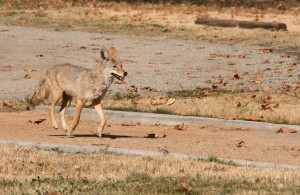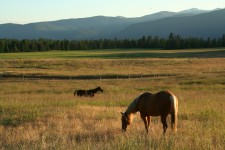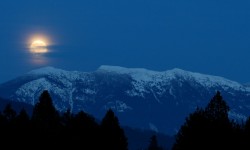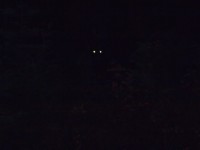As the light fades over the alfalfa field, the nighttime serenade begins with a long call, then a tremolo of howling. With all the howling and yipping it sounds like an entire pack of coyotes is calling, but I’ve learned that the serenade may only be one or two coyotes. Sometimes it sounds like they are howling in the yard but instead they are across the field.
The night song of coyotes is the most conspicuous sign of them in an area. Their song is higher pitched than that of a wolf. Another way they differ from wolves is that coyotes run with their tail held down while wolves run with their tail up or straight out.
A coyote’s vocalizations vary by season, time of day, lunar phase and social status in the pack. One reason coyotes howl is to signal territory boundaries to other packs. A pack of coyotes typically maintains a territory of four to eight square miles depending on the food availability, with a pack typically consisting of a mated pair with various aged offspring. Solitary coyotes (often pups and yearlings who have left the pack) don’t defend or maintain a territory.
Coyotes are considered opportunistic feeders–they eat whatever is available. I’ve seen them pouncing for rodents in open fields (in both winter and summer) and chasing down weaker birds near a pond. One of their main food sources is carrion (dead animals), especially in winter when there is more winter-kill. When the snow is too deep to pounce for rodents or when carrion is sparse, coyotes will hunt rabbits, fish and frogs. They will also eat insects, snakes, fruit, grass, lizards, nuts, garbage and pet food.
The versatility in their diet allows them to be highly adaptable to a wide variety of habitats. They are just as comfortable in forests, deserts and prairies as they are in suburbs, city parks and golf courses. This adaptability has allowed them to expand their range and become a common sight across most of North America.
I was surprised last winter to see a coyote stalking a flock of birds in the middle of an RV park on the outskirts of Los Angeles, California. Every morning the coyote would emerge from the thick brush along the creek and boldly trot around the park until it came upon the resident flock of waterfowl. Then it would switch into stalking mode and target a straggling bird, sometimes catching it, sometimes not. After successfully catching a meal or scaring the flock away, the coyote would trot right through the middle of the parked RV’s back to the forested creek. By nature, coyotes are fearful of humans, but they don’t seem to be fearful where they can’t be hunted.
I was truly surprised to see a coyote in the suburbs of Los Angeles. However, it wasn’t seeing them that first clued me in to their presence but instead hearing them over the drone of traffic as the sun set over a skyline of buildings.






Keep working ,splendid job!
Thanks for sharing superb informations. Your website is very cool. I’m impressed by the details that you¡¦ve on this site. It reveals how nicely you perceive this subject. Bookmarked this website page, will come back for extra articles. You, my pal, ROCK! I found just the information I already searched everywhere and just couldn’t come across. What a perfect web-site.